Abstract
Mammalian platelets vary widely in their responses to catecholamines in part because these agonists can act via excitatory alpha- and inhibitory beta-adrenoceptors. In the absence of antagonists, adrenaline enhances the response of rabbit platelets to an excitatory agonist, e.g. adenosine-5'-O-(1-thiodiphosphate) (ADP-alpha-s) acting at another receptor, but has no effect on the response of rat or guinea pig platelets to such an agonist. In the presence of a beta-adrenoceptor antagonist, adrenaline enhances the response of rat, but not guinea-pig platelets to ADP-alpha-S and the extent of the enhanced effect on rabbit platelets is increased. In the presence of an alpha-adrenoceptor antagonist, adrenaline inhibits the response of rabbit and rat platelets to ADP-alpha-S but has no such effect on the response of guinea-pig platelets. Studies using selective agonists and antagonists demonstrate that the excitatory response of rat platelets to adrenaline is mediated by an alpha 2-adrenoceptor, and the inhibitory response of rabbit platelets to adrenaline by a beta 2-adrenoceptor as is the case in other species which have been examined. The mean alpha 2-adrenoceptor density on human, rabbit, rat and guinea-pig platelets as assessed using [3H]-yohimbine as radioligand is obtained as 258, 270, 42 and less than 10 receptors per platelet. The mean beta 2-adrenoceptor density on human, rabbit, rat and guinea-pig platelets as assessed using (-)-[125I]-iodocyanopindolol is obtained as 66, 14, 41 and less than 5 receptors per platelet. The nature of the effect of adrenaline on the response of mammalian platelets to other excitatory agonists, e.g. ADP-alpha-S, appears therefore to be largely determined by the absolute number of alpha 2-adrenoceptors and by the relative content of alpha 2- and beta 2-adrenoceptors on these cells for the species which have been examined in this analysis.
Full text
PDF
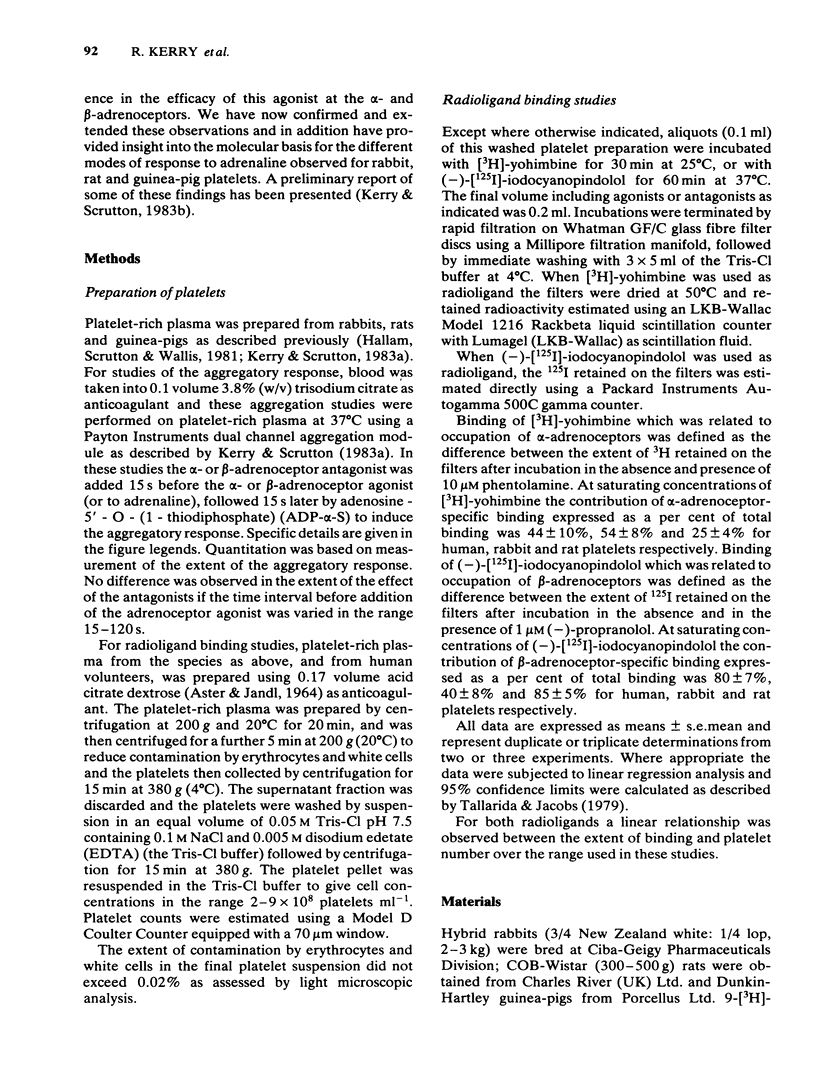

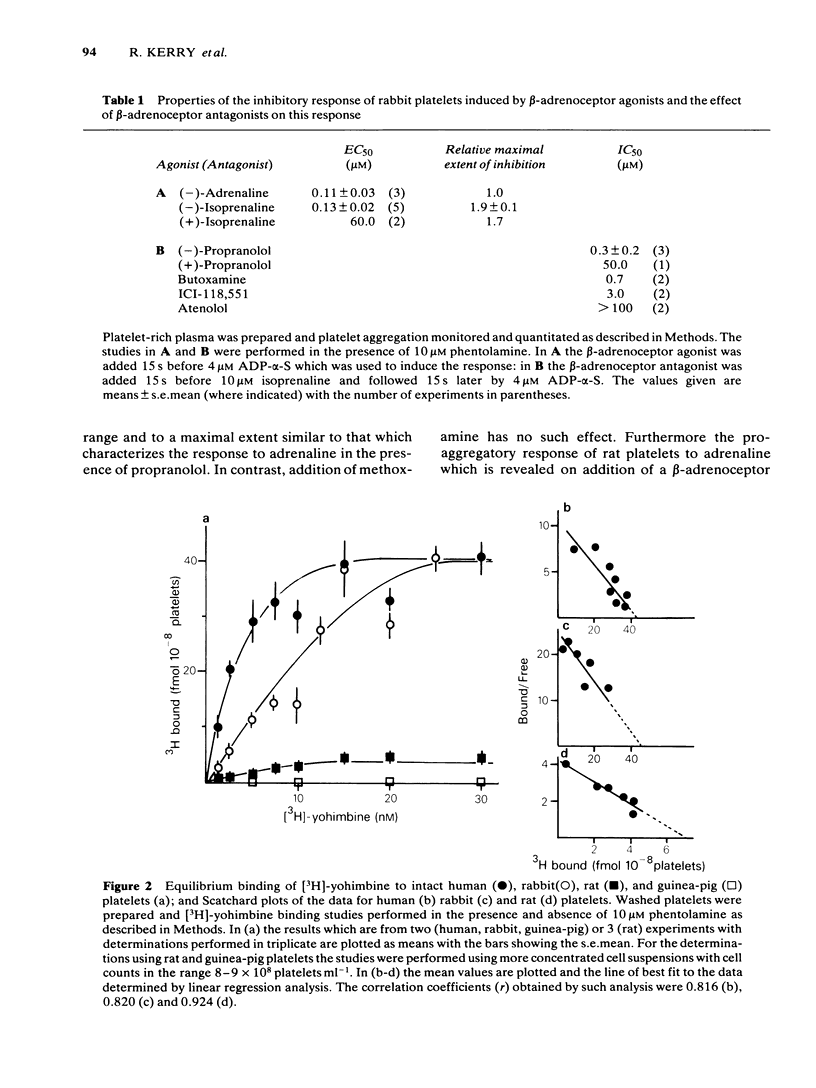
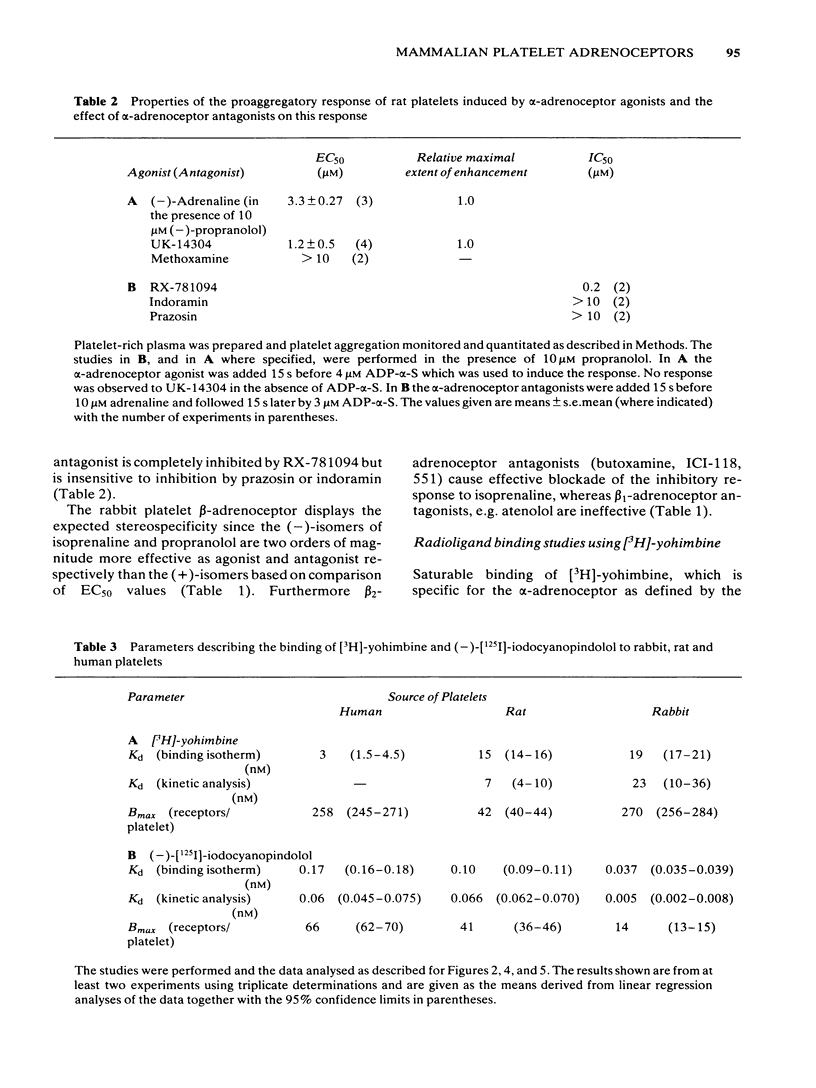

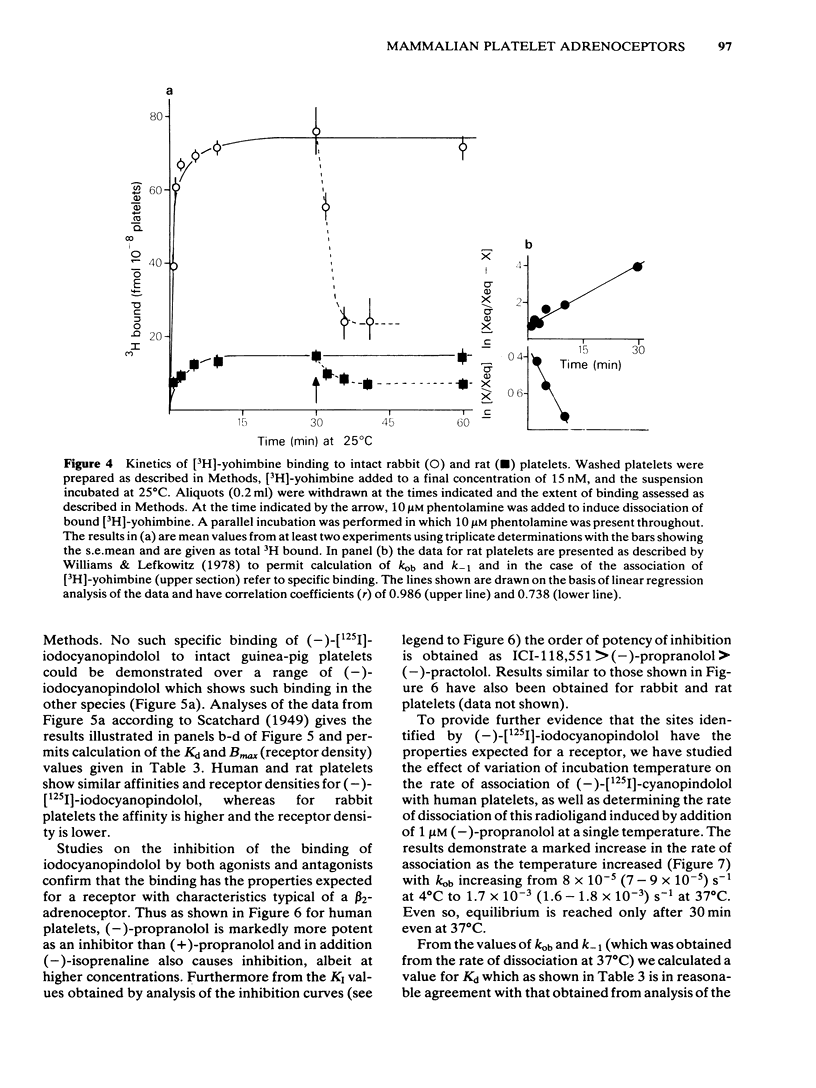
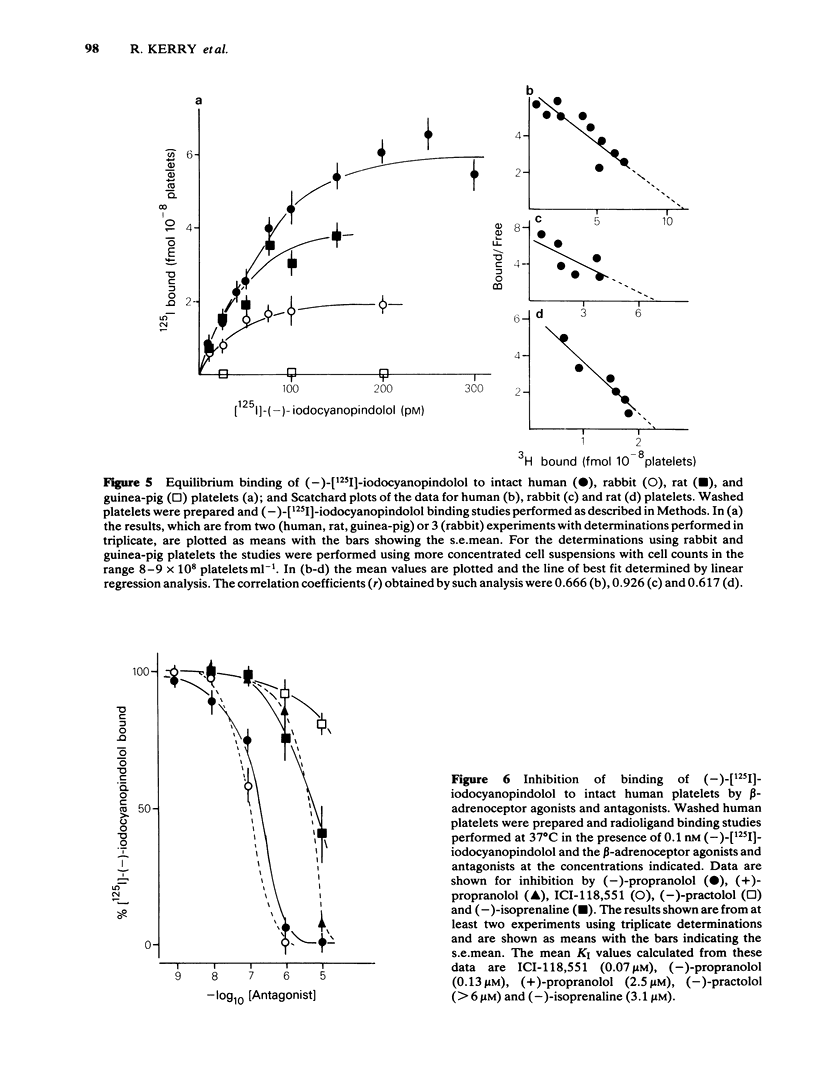
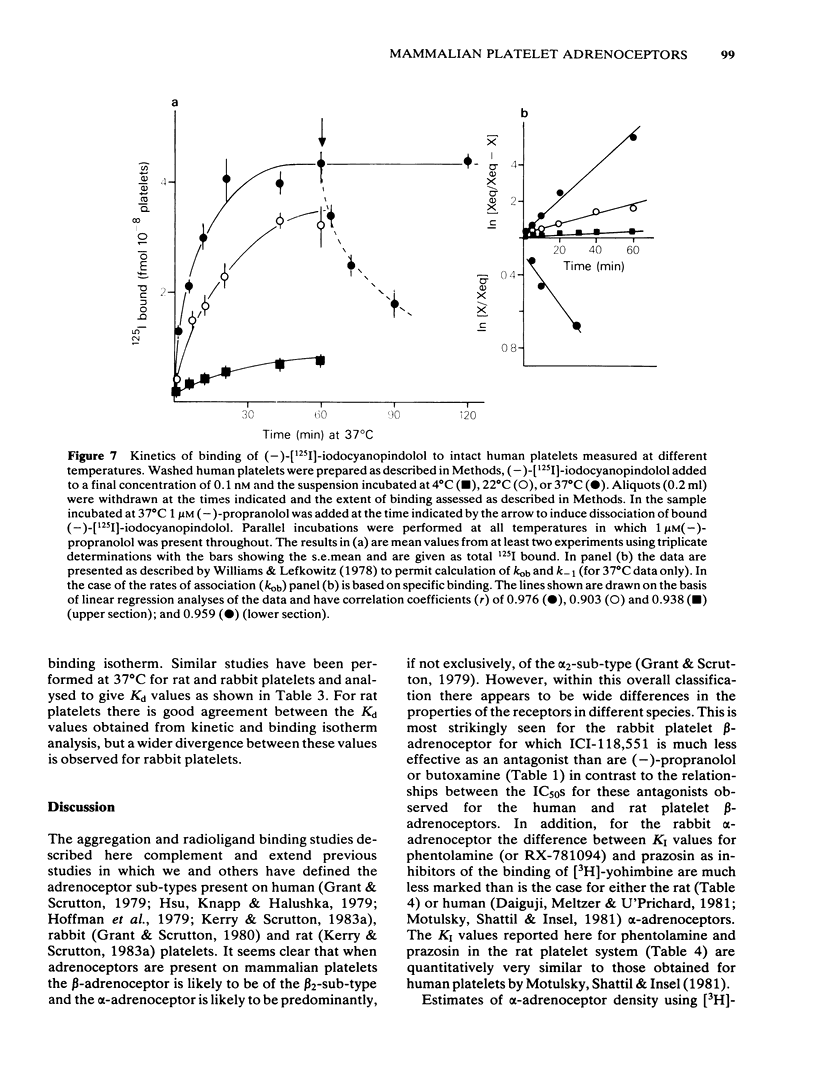

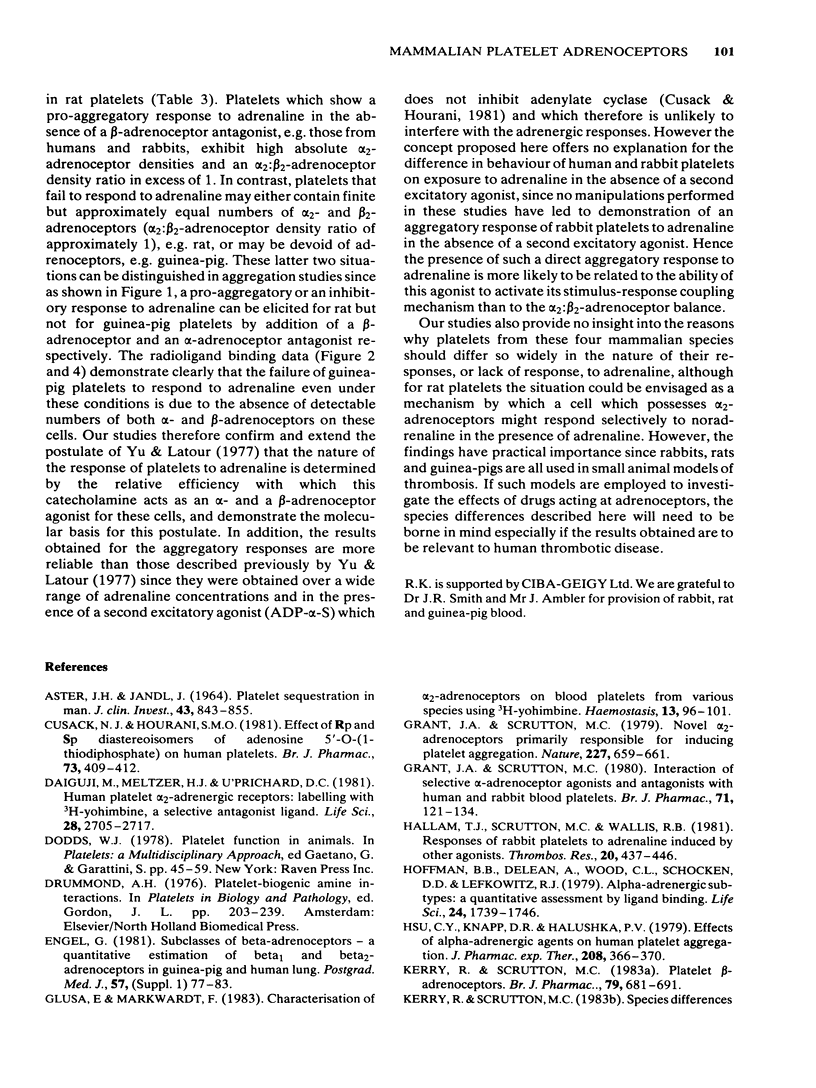

Selected References
These references are in PubMed. This may not be the complete list of references from this article.
- ASTER R. H., JANDL J. H. PLATELET SEQUESTRATION IN MAN. I. METHODS. J Clin Invest. 1964 May;43:843–855. doi: 10.1172/JCI104970. [DOI] [PMC free article] [PubMed] [Google Scholar]
- Cusack N. J., Hourani S. M. Effects of RP and SP diastereoisomers of adenosine 5'-O-(1-thiodiphosphate) on human platelets. Br J Pharmacol. 1981 Jun;73(2):409–412. doi: 10.1111/j.1476-5381.1981.tb10437.x. [DOI] [PMC free article] [PubMed] [Google Scholar]
- Daiguji M., Meltzer H. Y., U'Prichard D. C. Human platelet alpha 2-adrenergic receptors: labeling with 3H-yohimbine, a selective antagonist ligand. Life Sci. 1981 Jun 15;28(24):2705–2717. doi: 10.1016/0024-3205(81)90171-5. [DOI] [PubMed] [Google Scholar]
- Engel G. Subclasses of beta-adrenoceptors--a quantitative estimation of beta 1- and beta 2- adrenoceptors in guinea pig and human lung. Postgrad Med J. 1981;57 (Suppl 1):77–83. [PubMed] [Google Scholar]
- Glusa E., Markwardt F. Characterization of alpha 2-adrenoceptors on blood platelets from various species using 3H-yohimbine. Haemostasis. 1983;13(2):96–101. doi: 10.1159/000214710. [DOI] [PubMed] [Google Scholar]
- Grant J. A., Scrutton M. C. Interaction of selective alpha-adrenoceptor agonists and antagonists with human and rabbit blood platelets. Br J Pharmacol. 1980;71(1):121–134. doi: 10.1111/j.1476-5381.1980.tb10917.x. [DOI] [PMC free article] [PubMed] [Google Scholar]
- Grant J. A., Scrutton M. C. Novel alpha2-adrenoreceptors primarily responsible for inducing human platelet aggregation. Nature. 1979 Feb 22;277(5698):659–661. doi: 10.1038/277659a0. [DOI] [PubMed] [Google Scholar]
- Hoffman B. B., De Lean A., Wood C. L., Schocken D. D., Lefkowitz R. J. Alpha-adrenergic receptor subtypes: quantitative assessment by ligand binding. Life Sci. 1979 May 7;24(19):1739–1745. doi: 10.1016/0024-3205(79)90061-4. [DOI] [PubMed] [Google Scholar]
- Hsu C. Y., Knapp D. R., Halushka P. V. The effects of alpha adrenergic agents on human platelet aggregation. J Pharmacol Exp Ther. 1979 Mar;208(3):366–370. [PubMed] [Google Scholar]
- Kerry R., Scrutton M. C. Binding of [3H]-dihydroalprenolol and [3H]-acetobutolol to human blood platelets is not related to occupancy of beta-adrenoceptors. Thromb Res. 1983 Mar 15;29(6):583–594. doi: 10.1016/0049-3848(83)90213-x. [DOI] [PubMed] [Google Scholar]
- Loeb W. F., Mackey B. A comparative study of platelet aggregation in primates. J Med Primatol. 1973;2(3):195–205. doi: 10.1159/000460322. [DOI] [PubMed] [Google Scholar]
- Mills D. C., Smith J. B. The influence on platelet aggregation of drugs that affect the accumulation of adenosine 3':5'-cyclic monophosphate in platelets. Biochem J. 1971 Jan;121(2):185–196. doi: 10.1042/bj1210185. [DOI] [PMC free article] [PubMed] [Google Scholar]
- Motulsky H. J., Insel P. A. Adrenergic receptors in man: direct identification, physiologic regulation, and clinical alterations. N Engl J Med. 1982 Jul 1;307(1):18–29. doi: 10.1056/NEJM198207013070104. [DOI] [PubMed] [Google Scholar]
- Motulsky H. J., Shattil S. J., Insel P. A. Characterization of alpha 2-adrenergic receptors on human platelets using [3H]yohimbine. Biochem Biophys Res Commun. 1980 Dec 31;97(4):1562–1570. doi: 10.1016/s0006-291x(80)80044-1. [DOI] [PubMed] [Google Scholar]
- O'BRIEN J. R. SOME EFFECTS OF ADRENALINE AND ANTI-ADRENALINE COMPOUNDS ON PLATELETS IN VITRO AND IN VIVO. Nature. 1963 Nov 23;200:763–764. doi: 10.1038/200763a0. [DOI] [PubMed] [Google Scholar]
- Steer M. L., Atlas D. Demonstration of human platelet beta-adrenergic receptors using 125I-labeled cyanopindolol and 125I-labeled hydroxybenzylpindolol. Biochim Biophys Acta. 1982 Apr 7;686(2):240–244. doi: 10.1016/0005-2736(82)90118-3. [DOI] [PubMed] [Google Scholar]
- Yu S. K., Latour J. G. Potentiation by alpha and inhibition by beta-adrenergic stimulations of rat platelet aggregation. A comparative study with human and rabbit platelets. Thromb Haemost. 1977 Jun 30;37(3):413–422. [PubMed] [Google Scholar]


